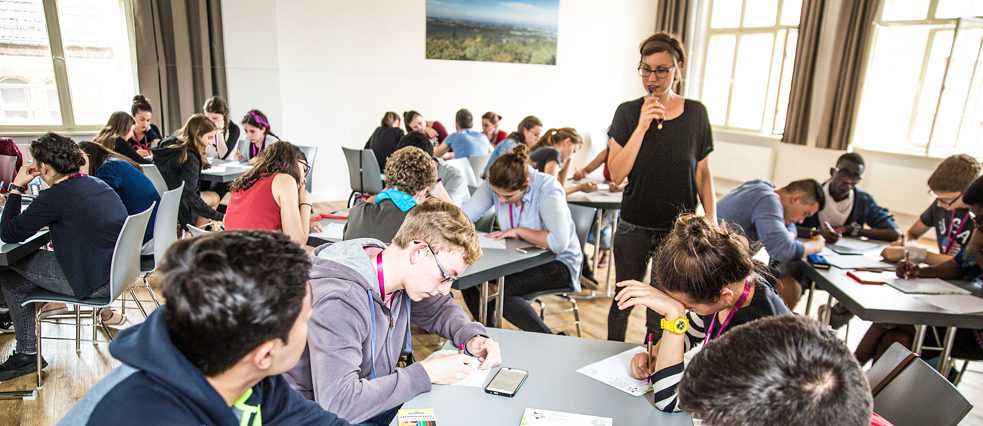Autonomy has been a buzzword in foreign language education for decades – placing the focus on the learner, fostering individual styles of learning and encouraging learners to take responsibility for their own progress. But what consequences does this have for the role of the teacher, and how can teachers best promote learner autonomy in their lessons?
Autonomy can be defined as the ability of learners to take the initiative in their own learning in a variety of situations and contexts. This includes the ability not only to take and follow through conscious decisions but also to create a suitable learning environment for themselves. Other skills that are encompassed by the term include the will to seek out people and situations that can facilitate the learning process, and the ability to reflect upon the learning process as a whole (Tassinari 2010).
Autonomy is not an all-or-nothing concept but one that evolves gradually. It comes about through the interplay of many factors, such as the attitudes and convictions of the participating teachers and learners, the interaction between them, the teaching and learning contexts and the prevailing institutional conditions.
Supporting and motivating teachers
Contrary to what is frequently believed, teachers play an important role when it comes to promoting autonomy: they listen attentively to the learners and motivate them to take the initiative in their own learning, and support them in formulating realistic goals for themselves and in incorporating these goals into a learning plan. They make material available and give both advice and constructive feedback. Insights from research and practice show that the role of teachers and the interaction between teachers and learners are important factors in developing autonomy (see Arnold & Fonseca-Mora 2016).
More decision-making freedom for learners
In lessons in which autonomy is encouraged, learners are called upon to play an active part in shaping the common learning process, for example by bringing their own materials to the classroom, learning to judge their own proficiency by making their own assessments or having their peers assess them, or by reflecting upon the learning processes by keeping a diary of their progress. By negotiating common goals, learning paths and indeed tasks, a community of learners is created that enriches the lesson.
This way of taking part in the lesson still feels unusual for many learners. To successfully initiate this process of reorientation, teachers should talk explicitly to learners about the subject of learner autonomy and gradually entrust them with more and more responsibility for the learning process.
Scharle and Szabó (2000) propose three steps to help learners attain greater autonomy: first, the teacher must make learners aware of autonomy by highlighting new ways of viewing the learning process and motivating the learners to reflect upon their learning process and their opportunities for learning, not only in but also outside the classroom. Then, by practising new skills, roles and behavioural patterns, the teacher can help learners to change their attitudes. Last but not least, more and more responsibility is transferred to the learners so that they can influence the lesson design and have greater scope for making and implementing their own decisions with respect to materials and exercises.
Example of a lesson that promotes autonomy
To illustrate this concept, let us take a lesson for B1 learners as an example.
The first thing the learners do when they enter the classroom is to rearrange the tables to create six “islands”. The teacher hands out index cards and folders: the tables are marked “Reading”, “Listening”, “Writing”, “Speaking”, “Grammar” and “Vocabulary”. Each folder contains texts and various exercises. The teacher places reference works and workbooks on the grammar table.
 Different tables can be used to physically separate different topics.
| Photo (detail): © Martin Welker
Different tables can be used to physically separate different topics.
| Photo (detail): © Martin Welker
In the previous lesson, the learners used a questionnaire to take stock of their progress so far and to identify areas in which they wish to improve their skills. They now sit down at the table relating to this area.
The learners look through the materials, pick an exercise and begin. They are free to use their smartphones, laptops or tablets to look things up or do some research. Depending on their personal preference, they either work in groups of two or three, or alone. The teacher sits down with each learner or group of learners in turn, listens to what they are doing, asks questions and makes suggestions.
A brief evaluation is conducted at the end of each exercise to discuss questions such as: What did you learn from this exercise? or How did you find the exercise, and why?
Some learners finish more quickly than others and pick a second exercise to tackle. Others may not be quite finished by the end of the lesson, and will finish off the exercise afterwards. The group that is focusing on grammar has questions about the verb forms. Together, they draw up a table listing specific verb forms that they wish to learn. They enter this table into the computer. Shortly before the end of the lesson, they present the table to the rest of the class. The other learners also give a report of what they have been working on, and questions are asked and answered. Then each learner picks an exercise to do for homework.
Using this kind of
learning circle in the classroom helps learners improve both their language and learning skills. Based on self-assessment, they learn among other things to set priorities for their learning, to share what they have learnt with others and to take decisions relating to their further learning.
Autonomy checklist for teachers
Acting autonomously does not depend solely on the attitudes, convictions and abilities of the individual, but also on the institutional framework conditions. We therefore need to be conscious of all of these factors if we are to create new scope for autonomous learning. This checklist, based on Lamb, Jiménez Raya and Vieira (2007: 47-53), can serve as useful inspiration for self-reflection:
- Attitudes and will: Am I really convinced by the idea of autonomy? What do I hope it will achieve?
- Implementation and flexibility: How can I deal with local constraints and create scope for autonomous learning nonetheless?
- Allies and communication: With which other colleagues can I share thoughts and ideas? Who can serve as role models – including in other spheres of life?
 Sharing thoughts and ideas about learner autonomy with colleagues is also very helpful.
| Photo (detail): © contrastwerkstatt - Fotolia.com
Sharing thoughts and ideas about learner autonomy with colleagues is also very helpful.
| Photo (detail): © contrastwerkstatt - Fotolia.com
Taking the first steps
This process of self-reflection is followed by the first step towards greater autonomy. Set yourself concrete goals – for example that you will enable learners in your class to present their favourite texts to the rest of the group. Small steps are better than none at all.
Also think about the ideas and materials that you could use in lessons aimed at promoting autonomy. These include (more) open-ended exercises, learning scenarios and projects.
Consider what you have developed and put into practice, and how it was received. You can do this by keeping a diary, and indeed by talking to other teachers and the learners. However, the most important thing is to stick with it, even if things do not immediately work out the way you had imagined.
Literature
Arnold, Jane/Fonseca-Mora, Carmen (2016): Affektive Faktoren und Autonomie beim Fremdsprachenlernen. In: Martos, Javier/Tassinari, Maria G. (Ed.): Intercultural German Studies (= Jahrbuch Deutsch als Fremdsprache; 40). Munich: Iudicium, p. 163–176.
Dam, Leni (1995): Learner autonomy 3. From theory to classroom practice. Dublin: Authentik.
Lamb, Terry/Jiménez Raya, Manuel/Vieira, Flavia (2007): Pedagogy for Autonomy in Language Education in Europe. Dublin: Authentik.
Rogers, Carl R. (1984): Freiheit und Engagement. Personenzentriertes Lehren und Lernen. Munich: Kösel.
Scharle, Agota/Szabó Anita (2000): Learner autonomy. A guide to developing learner responsibility. Cambridge: Cambridge University Press.
Tassinari, Maria G. (2010): Autonomes Fremdsprachenlernen: Komponenten, Kompetenzen, Strategien. Frankfurt am Main: Peter Lang.


